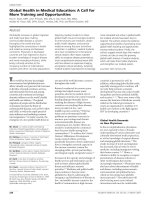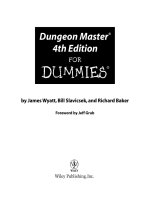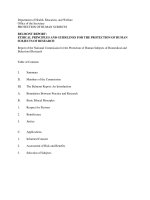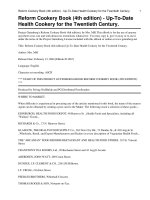The Anatomy Coloring Book, 4th Edition
Bạn đang xem bản rút gọn của tài liệu. Xem và tải ngay bản đầy đủ của tài liệu tại đây (37.7 MB, 381 trang )
Wynn Kapit / Lawrence M. Elson
The
ANATOMY
COLORING BOOK
FOURTH EDITION
Boston
Amsterdam
Delhi
Columbus
Cape Town
Mexico City
Indianapolis
New York
Dubai London
São Paulo
Sydney
San Francisco
Madrid Milan
Hong Kong
Munich
Seoul
Upper Saddle River
Paris
Singapore
Montréal
Taipei
Toronto
Tokyo
Editor-in-Chief: Serina Beauparlant
Associate Editor: Nicole McFadden
Director of Development: Barbara Yien
Text Permissions Associate Project Manager: Michael Farmer
Text Permissions Specialist: S4 Carlisle
Senior Managing Editor: Deborah Cogan
Production Project Manager: Caroline Ayres/Michael Penne
Copyeditor: Brooke Graves/Graves Editorial Service
Production Management and Composition: Integra
Design Manager: Marilyn Perry
Interior Designer: Howie Severson
Cover Designer: Wynn Kapit, Riezebos Holzbaur Design Group
Senior Manufacturing Buyer: Stacey Weinberger
Marketing Manager: Derek Perrigo
Library of Congress Cataloging-in-Publication Data
Kapit, Wynn.
The anatomy coloring book/Wynn Kapit, Lawrence M. Elson.—4th ed.
p.; cm.
Includes bibliographical references and index.
ISBN 978-0-321-83201-6
I. Elson, Lawrence M., 1935- II. Title.
[DNLM: 1. Anatomy—Atlases. 2. Anatomy—Terminology—English. QS 15]
611—dc23
2012029126
Copyright © 2014, 2002, 1995, 1977 by Wynn Kapit and Lawrence M. Elson.
Published by Pearson Education, Inc., 1301 Sansome St., San Francisco, CA 94111.
All rights reserved. Manufactured in the United States of America. This publication is
protected by Copyright and permission should be obtained from the publisher prior
to any prohibited reproduction, storage in a retrieval system, or transmission in any
form or by any means, electronic, mechanical, photocopying, recording, or likewise.
To obtain permission(s) to use material from this work, please submit a written request
to Pearson Education, Inc., Permissions Department, 1900 E. Lake Ave., Glenview, IL
60025. For information regarding permissions, call (847) 486-2635.
Many of the designations used by manufacturers and sellers to distinguish their
products are claimed as trademarks. Where those designations appear in this book,
and the publisher was aware of a trademark claim, the designations have been printed
in initial caps or all caps.
1 2 3 4 5 6 7 8 9—EBM—18 17 16 15 14 13
www.pearsonhighered.com
ISBN-13: 978-0-321-83201-6
ISBN-10:
0-321-83201-9
DEDICATION
For my wife, Lauren, and sons, Neil and Eliot.
—WYNN KAPIT
This edition is dedicated to the millions of students of anatomy, and
their teachers, who have used this book in the pursuit of visualizing and
understanding the structure and function of the human body by “hands
on” coloring of structure, related nomenclature, and structural and functional relationships. Their diligent and successful acquisition of anatomic
knowledge, and its application to their professional and personal lives,
gives evidence of the value of kinesthetic (tactile) learning. May their new
insights make the world a better place.
—LARRY ELSON
ABOUT THE AUTHORS
WYNN KAPIT
Wynn Kapit, the designer and illustrator of this book, has had careers in law,
graphic and advertising design, painting, and teaching.
In 1955, he graduated from law school, with honors, from the University
of Miami and was admitted to the Florida Bar. He practiced law both before
and after military service. Four years later, he decided to pursue a childhood
ambition and enrolled at what is now the Art Center College in Los Angeles,
where he studied graphic design. Afterwards, he worked in the New York
advertising world for six years as a designer and art director. He “dropped
out” in the late 1960s, returned to California, and began painting. His
numerous exhibitions included a one-man show at the California Palace of
the Legion of Honor in 1968. He returned to school and received a master’s
degree in painting from the University of California at Berkeley in 1972.
Kapit was teaching figure drawing in Adult Ed in San Francisco in 1975
when he decided he needed to learn more about bones and muscles. He
enrolled in Dr. Elson’s anatomy class at San Francisco City College. While
he was a student, he created the word-and-illustration coloring format that
seemed to be a remarkably effective way of learning the subject. He showed
some layouts to Dr. Elson and indicated his intention to do a coloring book
on bones and muscles for artists. Immediately recognizing the potential of
this method, Dr. Elson encouraged Kapit to do a “complete” coloring book
on anatomy and offered to collaborate on the project. The first edition of The
Anatomy Coloring Book was published in 1977, and its immediate success
inspired the development of a completely new field of publishing: educational
coloring books.
Kapit went on to create The Physiology Coloring Book with the assistance
of two professors who were teaching at Berkeley: Dr. Robert I. Macey and
Dr. Esmail Meisami. That book was published in 1987 and has gone through
two editions. In the early 1990s, Kapit wrote and designed The Geography
Coloring Book, now in its second edition.
LAWRENCE M. ELSON
Lawrence M. Elson, PhD, planned the content and organization, provided
sketches, and wrote the text for the book. This is his seventh text, having
authored It’s Your Body and The Zoology Coloring Book and co-authored
The Human Brain Coloring Book and The Microbiology Coloring Book. He
received his BA in zoology and pre-med at the University of California at
Berkeley and continued there to receive his PhD in human anatomy. Dr. Elson
was assistant professor of anatomy at Baylor College of Medicine in Houston,
participated in the development of the Physician’s Assistant Program, lectured and taught dissection anatomy at the University of California School of
Medicine in San Francisco, and taught general anatomy, from protozoons to
humans, at City College of San Francisco.
In his younger days, Dr. Elson trained to become a naval aviator and
went on to fly dive-bombers off aircraft carriers in the Western Pacific. While
attending college and graduate school, he remained in the Naval Air Reserve
and flew antisubmarine patrol planes and helicopters. His last position in his
20-year Navy career was as commanding officer of a reserve antisubmarine
helicopter squadron.
Dr. Elson is a consultant to insurance companies and personal injury and
medical malpractice attorneys on causation-of-injury/death issues, a practice
that has taken him throughout the United States and Canada. He has testified
in hundreds of personal injury trials and arbitrations. His research interests are
focused on the anatomic bases of myofascial pain arising from low velocity
accidents.
You can contact him at
iv
TABLE OF CONTENTS
x
xi
xii
PREFACE
ACKNOWLEDGMENTS
INTRODUCTION TO COLORING
ORIENTATION TO THE BODY
1
2
3
4
5
Anatomic Planes & Sections
Terms of Position & Direction
Systems of the Body (1)
Systems of the Body (2)
Cavities & Linings
CELLS & TISSUES
6
7
8
9
10
11
12
13
14
The Generalized Cell
Cell Division / Mitosis
Tissues: Epithelial
Tissues: Fibrous Connective Tissues
Tissues: Supporting Connective Tissues
Tissues: Muscle
Tissues: Skeletal Muscle Microstructure
Tissues: Nervous
Integration of Tissues
INTEGUMENTARY SYSTEM
15
16
The Integument: Epidermis
The Integument: Dermis
SKELETAL & ARTICULAR SYSTEMS
17
18
19
20
21
22
23
24
25
26
27
28
29
30
31
32
33
34
35
36
37
Long Bone Structure
Endochondral Ossification
Axial / Appendicular Skeleton
Classification of Joints
Terms of Movements
Bones of the Skull (1)
Bones of the Skull (2)
Temporomandibular Joint (Craniomandibular)
Vertebral Column
Cervical & Thoracic Vertebrae
Lumbar, Sacral, & Coccygeal Vertebrae
Bony Thorax
Upper Limb: Pectoral Girdle & Humerus
Upper Limb: Glenohumeral Joint for B and C (Shoulder joint)
Upper Limb: Bones of the Forearm
Upper Limb: Elbow & Related Joints
Upper Limb: Bones / Joints of the Wrist & Hand
Upper Limb: Bones / Joints in Review
Lower Limb: Hip Bone, Pelvic Girdle, & Pelvis
Lower Limb: Male & Female Pelves
Lower Limb: Sacroiliac & Hip Joints
v
38
39
40
41
Lower Limb: Bones of the Thigh & Leg
Lower Limb: Knee Joint
Lower Limb: Ankle Joint & Bones of the Foot
Lower Limb: Bones & Joints in Review
MUSCULAR SYSTEM
42
43
44
45
46
47
48
49
50
51
52
53
54
55
56
57
58
59
60
61
62
63
64
65
66
67
Introduction to Skeletal Muscle
Integration of Muscle Action
Head: Muscles of Facial Expression
Head: Muscles of Mastication
Neck: Anterior & Lateral Muscles
Torso: Deep Muscles of the Back & Posterior Neck
Torso: Muscles of the Bony Thorax & Posterior Abdominal Wall
Torso: Muscles of the Anterior Abdominal Wall & Inguinal Region
Torso: Muscles of the Pelvis
Torso: Muscles of the Perineum
Upper Limb: Muscles of Scapular Stabilization
Upper Limb: Muscles of the Musculotendinous Cuff
Upper Limb: Movers of the Shoulder Joint
Upper Limb: Movers of Elbow & Radioulnar Joints
Upper Limb: Movers of Wrist & Hand Joints (Extrinsics)
Upper Limb: Movers of Hand Joints (Intrinsics)
Upper Limb: Review of Muscles
Lower Limb: Muscles of the Gluteal Region
Lower Limb: Muscles of the Posterior Thigh
Lower Limb: Muscles of the Medial Thigh
Lower Limb: Muscles of the Anterior Thigh
Lower Limb: Muscles of the Anterior & Lateral Leg
Lower Limb: Muscles of the Posterior Leg
Lower Limb: Muscles of the Foot (Intrinsics)
Lower Limb: Review of Muscles
Functional Overview
NERVOUS SYSTEM
68
69
70
71
Organization
Functional Classification of Neurons
Synapses & Neurotransmitters
Neuromuscular Integration
CENTRAL NERVOUS SYSTEM
72
73
74
75
76
77
78
79
vi
Development of the Central Nervous System (CNS)
Cerebral Hemispheres
Tracts / Nuclei of Cerebral Hemispheres
Diencephalon
Brain Stem / Cerebellum
Spinal Cord
Ascending Tracts (Pathways)
Descending Tracts
CENTRAL NERVOUS SYSTEM: CAVITIES & COVERINGS
80
81
82
Ventricles of the Brain
Meninges
Circulation of Cerebrospinal Fluid (CSF)
PERIPHERAL NERVOUS SYSTEM
83
84
85
86
87
88
89
90
Cranial Nerves
Spinal Nerves & Nerve Roots
Spinal Reflexes
Distribution of Spinal Nerves
Brachial Plexus & Nerves to the Upper Limb
Lumber & Sacral Plexuses: Nerves to the Lower Limb
Dermatomes
Sensory Receptors
AUTONOMIC (VISCERAL) NERVOUS SYSTEM
91
92
93
ANS: Sympathetic Division (1)
ANS: Sympathetic Division (2)
ANS: Parasympathetic Division
SPECIAL SENSES
94
95
96
97
98
99
Visual System (1)
Visual System (2)
Visual System (3)
Auditory & Vestibular Systems (1)
Auditory & Vestibular Systems (2)
Taste & Smell
CARDIOVASCULAR SYSTEM
100
101
102
103
104
105
106
107
108
109
110
111
112
113
114
115
116
117
118
119
Blood & Blood Elements
Scheme of Blood Circulation
Blood Vessels
Mediastinum, Walls, & Coverings of the Heart
Chambers of the Heart
Cardiac Conduction System & the ECG
Coronary Arteries & Cardiac Veins
Arteries of the Head & Neck
Arteries of the Brain
Arteries & Veins of the Upper Limb
Arteries of the Lower Limb
Aorta, Branches, & Related Vessels
Arteries to Gastrointestinal Tract & Related Organs
Arteries of the Pelvis & Perineum
Review of Principal Arteries
Veins of the Head & Neck
Caval & Azygos Systems
Veins of the Lower Limb
Hepatic Portal System
Review of Principal Veins
vii
LYMPHATIC SYSTEM
120
Lymphatic Drainage & Lymphocyte Circulation
IMMUNE (LYMPHOID) SYSTEM
121
122
123
124
125
126
Introduction
Innate & Adaptive Immunity
Thymus & Red Marrow
Spleen
Lymph Node
Mucosal Associated Lymphoid Tissue (M.A.L.T.)
RESPIRATORY SYSTEM
127
128
129
130
131
132
133
Overview
External Nose, Nasal Septum, & Nasal Cavity
Paranasal Air Sinuses
Pharynx & Larynx
Lobes & Pleura of the Lungs
Lower Respiratory Tract
Mechanism of Respiration
DIGESTIVE SYSTEM
134
135
136
137
138
139
140
141
142
143
Overview
Oral Cavity & Relations
Anatomy of a Tooth
Pharynx & Swallowing
Peritoneum
Esophagus and Stomach
Small Intestine
Large Intestine
Liver
Biliary System & Pancreas
URINARY SYSTEM
144
145
146
147
148
Urinary Tract
Kidneys & Related Retroperitoneal Structures
Kidney & Ureter
The Nephron
Tubular Function & Renal Circulation
ENDOCRINE SYSTEM
149
150
151
152
153
154
viii
Introduction
Pituitary Gland & Hypothalamus
Pituitary Gland & Target Organs
Thyroid & Parathyroid Glands
Adrenal (Suprarenal) Glands
Pancreatic Islets
REPRODUCTIVE SYSTEM
155
156
157
158
159
160
161
162
Male Reproductive System
Testis
Male Urogenital Structures
Female Reproductive System
Ovary
Uterus, Uterine Tubes, & Vagina
Menstrual Cycle
Breast (Mammary Gland)
BIBLIOGRAPHY AND REFERENCES
APPENDIX A: ANSWER KEYS (TO REVIEWS ON PAGES 34, 41,
58, 66, 114, 119)
APPENDIX B: SPINAL INNERVATION OF SKELETAL MUSCLES
GLOSSARY
INDEX
ix
PREFACE
“A picture is worth a thousand words,” states one Chinese proverb.
Another says “. . . a million words.” Indeed it is! And we are proud to present our fourth edition with a new and improved design, primarily reflected
in the increased size of the illustrations and the addition of a separate text
page adjacent to each related illustration.
This may be your first scientific higher education (college, graduate,
and professional level) coloring book. In fact, we assume it is. A look inside—at first glance—may prove daunting! Stick with us, follow our lead,
and you will come away from the experience with greater understanding
than you can imagine.
You have been here before perhaps: while holding a conversation with
your teacher you got lost in her words. The teacher then pulled out a pad
of paper, and said, as she began drawing, “Look,” and your eyes riveted
on the paper before you as the illustrative explanation evolved. And, when
your teacher finished her presentation, you saw the light. So, you are a
visual learner! You looked at the drawing for a minute, and then said, “Can
I draw what I see, and you tell me if I’m on the right track?” You took pencil
in hand and illustrated your understanding, and, as you did, the meaning
became even clearer. So, you are also a kinesthetic (hands-on) learner—
you learn by doing! This book is designed for and dedicated to you.
We are offering instruction to a much broader audience than do typical texts, and there may be topics to be colored that are challenging to a
first-year college student but not so challenging for a first-year medical
or physical therapy student. If a page of illustration(s) confuses you, step
back and look at the drawing(s) in the context of its place in the body.
Keep going back to larger and more expanded views until you are comfortable with that level; then go one level deeper. Review the numerical
order of coloring in the list of names; you may have missed something.
Check the glossary or consult your major text or given reference. Also, if
you have any suggested corrections, please let me (Elson) know. We really
want you to have a positive learning experience, and have a sense of
reward in seeing your completed work. After all, it’s your body!
We are grateful to the thousands of colorers who have advised and
encouraged us, including coaches, trainers, teachers, paramedics, body
workers, court reporters, attorneys, insurance claims adjusters, judges,
students and practitioners of dentistry and dental hygiene, nursing, medicine/surgery, chiropractic, podiatry, massage therapy, myotherapy, physical therapy, occupational therapy, exercise therapy, dance, and music!
More informal seekers of self-realization and those with impairments have
also been drawn to The Anatomy Coloring Book because of its lighter,
more visual approach to understanding. Truly, a picture is worth a thousand words!
Happy Coloring!
x
ACKNOWLEDGMENTS
Mary and Jason Luros: Your advice and counsel was much appreciated
and for that I thank you.
Lindsey Fairleigh: Thank you for editing the rough script and formatting
Microsoft Word so I could develop the typescript in consistent fashion,
and for just being a good “ear,” competent editor, and friend throughout
the project.
Bill Neuman, PE: Thank you for helping me out with keystones and gravitational forces and all matters of engineering related to the human body.
Glen Giesler, PhD: Your contribution to the functional organization of cranial nerves was much appreciated.
Hedley Emsley, PhD, MRCP: Thank you for your kind review of the dermatomal map used in this book.
Eric Ewig, PT: Your insight on musculoskeletal function and dysfunction
from the physical therapist’s clinical perspective was invaluable. You were
most helpful!
And last but not least to my wife, Ellyn, without whose love and
understanding this project would have never been completed.
WYNN KAPIT
Santa Barbara, CA
LARRY ELSON
Napa Valley, CA
xi
Introduction To Coloring
(Important tips on how to get the most out of this book)
How The Book Is Arranged
How The Coloring System Works
The book is divided by subject matter into sections.
Each section contains many topics. Each topic consists of a page of illustrations, and a column of text on
the page facing it.
It is not important that you color the sections in
order, but for whichever section you select you should
color the pages in order. You may wish to read through
the text before coloring, and reread it more carefully
afterward; or you may choose to color first. But always
read the coloring notes (CN) before coloring. They let
you know if certain colors are required, as well as what
order to color in and what to look out for.
Structures (the parts of the illustrations to be colored),
are identified by names presented in outlined (colorable)
lettering. Each name has a small letter (A–Z) or number
(subscript, letter label) following it. This letter label connects the name with its related structure in the illustration. Name and structure are to receive the same color.
Look at the cover for a colored example.
Boundaries of the structures are defined by dark
lines. Color over everything within the boundaries. The
label may be found either within the structure or connected to it by a light line. Not every structure to be
colored is labeled. When structures similar in size and
shape lie adjacent to each other, color them all with
the same color even if some are not labeled.
It is important to color the names; they guide you
through the order of coloring. Coloring also promotes
memorization. You may also find very slight spacing
between letters in the names according to syllables.
These groupings, along with the glossary in the back,
help with learning pronunciation of these unfamiliar
words. Indentations in the list of names reflect important relationships among the structures.
A different color is required for each name and its
letter label, except where different names are followed
by the same letter but have different superscripts
(e.g., D1, D2, shown on the opposite page). They (D–D2)
all receive the “D” color because of a close relationship
between the structures to which they refer. Even when
restricted to a single color you may distinguish between
such related names and structures by creating different values with varying pressure on the pencil. If you
run out of colors because of a very long list of names,
it will obviously be necessary to repeat a color and use
it on more than one name. Except where indicated, you
may choose your own colors. Lighter ones are advised
for large areas, and dark or bright colors for the smaller
structures that are harder to see.
Red is usually associated with arteries, blue with
veins, purple with capillaries, yellow with nerves, and
green with lymphatics. However, on pages dealing
exclusively with any of these structures, you will naturally have to use many colors for the different structures in the same group.
Coloring Tools
Colored pencils are preferred. They won’t show
through to the other side of the page. With colored
pens, test each color on a page in the back of the
book to see if it shows through. Lighter colors and
water-based pens will be less likely to do so; their
transparent qualities also allow details and labels on
the illustration to remain visible.
At least 10 colors are necessary. One of them
should be a medium gray. A single colored pencil can
virtually create many colors, as varying the point pressure produces a range of light and dark values. If you
purchase your colors individually, such as at stores
selling art supplies, then choose mostly lighter colors.
You will need red, blue, purple, yellow, gray, and
black. Buying colors individually also enables replacement when a pencil is lost or used-up.
xii
symbols used throughout the book
Abbreviations
In the text, the following abbreviations (in upper or
lower case) may precede or follow the names of the
structures identified due to space limitations.
e.g., Post. auricular m., Brachial a., Scalenus
med. m.
A., As. = Artery(ies)
Ant. = Anterior
Br., Brs. = Branch(es)
Inf. = Inferior
Lat. = Lateral
Lig. = Ligament
M., Ms. = Muscle(s)
Med. (preceding term) = Medial
Med. (after term) = Medius
N., Ns. = Nerve(s)
Post. = Posterior
Sup. = Superior, superficial
Sys. = System
Tr. = Tract
V., Vs. = Vein(s)
xiii
Study of the human body requires an organized visualization of its
internal parts. Dissection (dis, apart; sect, cut) is the term given to
preparation of the body for general or specific internal inspection.
Internal body structure is studied in sections cut along imaginary
flat surfaces called planes. These planes are applied to the erect,
standing body with limbs extended along the sides of the body,
palms and toes forward, thumbs outward. See this “anatomical
position” in the following page. Views of the internal body in life
and after death can be obtained by a number of techniques that
produce computer-generated representational images of human
structure in series (sections) along one or more planes. These
anatomic images may be produced by computerized tomography
(CT) and magnetic resonance imaging (MRI).
The median plane is the midline longitudinal plane dividing the
head and torso into right and left halves. The presence of the
sectioned midline of the vertebral column and spinal cord is characteristic of this plane. Planes parallel to the median plane are
sagittal. Watch out! “Medial” is not a plane.
The sagittal plane is a longitudinal plane dividing the body (head,
torso, limbs) or its parts into left and right parts (not halves). It is
parallel to the median plane.
The coronal or frontal plane is a longitudinal plane dividing the
body or its parts into front and back halves or parts. These planes
are perpendicular to the median and sagittal planes.
The transverse or cross plane divides the body into upper and
lower halves or parts (cross sections). This plane is perpendicular
to the longitudinal planes. Transverse planes are horizontal planes
of the body in the anatomical position.
Orientation to the Body
Anatomic Planes & Sections
CN: Use your lightest colors on A–D. (1) Color a body
plane in the center diagram; then color its name, related
sectional view, and the sectioned body example. (2) Color
everything within the dark outlines of the sectional views.
1
Terms of position and direction describe the relationship of one
structure on/in the body to another with reference to the anatomical
position: body standing erect, limbs extended, palms of the hands
forward, thumbs directed outwardly.
Cranial and superior refer to a structure being closer to the top
of the head than another structure in the head, neck, or torso
(excluding limbs).
Anterior refers to a structure being more in front than another structure in the body. Ventral refers to the abdominal side; in bipeds, it is
synonymous with anterior. Rostral refers to a beak-like structure in
the front of the head or brain that projects forward.
Posterior and dorsal refer to a structure being more in back than
another structure in the body. Dorsal is synonymous with posterior
(the preferred term) except in quadrupeds.
Medial refers to a structure that is closer to the median plane than
another structure in the body.
Lateral refers to a structure that is farther away from the median
plane than another structure in the body.
Employed only with reference to the limbs, proximal refers to a
structure being closer to the median plane or root of the limb than
another structure in the limb.
Employed only with reference to the limbs, distal refers to a structure being farther away from the median plane or the root of the
limb than another structure in the limb.
Caudal and inferior refer to a structure being closer to the feet
or the lower part of the body than another structure in the body.
These terms are not used with respect to the limbs. In quadrupeds, caudal means closer to the tail.
The term superficial is synonymous with external, the term deep
with internal. Related to the reference point on the chest wall, a
structure closer to the surface of the body is superficial; a structure
farther away from the surface is deep.
Ipsilateral means “on the same side” (in this case, as the reference
point); contralateral means “on the opposite side” (of the reference
point).
The quadruped presents four points of direction: head end (cranial),
tail end (caudal), belly side (ventral), and back side (dorsal).
Orientation To The Body
Terms Of Position & Direction
CN: Color the arrows and the names of the positions
and directions, but not the illustrations.
2
See 1
Collections of similar cells constitute tissues. The four basic tissues
are integrated into body wall and visceral structures/organs. A
system is a collection of organs and structures sharing a common
function. Organs and structures of a single system occupy diverse
regions in the body and are not necessarily grouped together.
The skeletal system consists of bones and the ligaments that
secure the bones at joints.
The articular system comprises both fixed and movable joints.
The muscular system includes the skeletal muscles that move
the skeleton, the face, and other structures, and give form to the
body; cardiac muscle pumps blood through the heart; smooth
muscle moves the contents of viscera, vessels, and glands, and
also moves the hair on skin.
The cardiovascular system consists of the four-chambered
heart; arteries conducting blood to the tissues; capillaries
through which nutrients, gases, and molecular material pass to
and from the tissues; and veins returning blood from the tissues
to the heart.
The lymphatic system is a system of vessels assisting the veins
in recovering the body’s tissue fluids and returning them to the
heart. Lymph nodes filter lymph throughout the body.
The nervous system consists of impulse-generating/-conducting
tissue organized into a central nervous system (brain and spinal
cord) and a peripheral nervous system (nerves). The peripheral
nervous system includes the visceral (autonomic) nervous system,
which is involved in involuntary “fight or flight” and vegetative
functions.
The endocrine system consists of glands that secrete chemical
agents (hormones) into the tissue fluids and blood, affecting the
function of multiple areas of the body—not the least of which is
the brain. Hormones help maintain balanced metabolic functions
in many of the body’s systems.
The integumentary system consists of the skin, which is
provided with many glands, sensory receptors, vessels, immune
cells, antibodies, and layers of cells and keratin that resist environmental factors harmful to the body.
Orientation To The Body
Systems Of The Body (1)
CN: It is important to use very light
colors for this page and the next to
retain the details of the illustrated body
systems. For future reference, try to
impress yourself with an overall general
image of each system, without specific details. (1) For realism, color the
muscular system, B, brown; lymphatic,
E, green; nervous, F, yellow; endocrine, G, orange; and integumentary,
H, the color of your own skin. (2) The
cardiovascular system’s name remains
uncolored; arteries, C, and veins, D,
are to be colored red and blue, respectively. (3) Apply variations of red and
blue for the smallest vessels.
3
See 4
The respiratory system consists of the upper (nose through larynx)
and lower respiratory tract (trachea through the air spaces of the
lungs). Most of the tract is airway; only the air spaces (alveoli) and
very small bronchioles exchange gases between alveoli and the
lung capillaries.
The digestive system consists of an alimentary canal and glands. It
performs the breakdown, digestion, and assimilation of food as well
as excretion of the residua. Glands include the liver, the pancreas,
and the biliary system (gallbladder and related ducts).
The urinary system is responsible for the conservation of water
and maintenance of a neutral acid–base balance in the body fluids.
The kidneys are the main functionaries of this system; residual fluid
(urine) is excreted through ureters to the urinary bladder for retention and discharged to the outside through the urethra.
The immune/lymphoid system consists of multiple organs involved
in body defense. This system includes a diffuse arrangement of
immune-related cells throughout the body; these cells resist invasive
microorganisms and remove damaged or otherwise abnormal cells.
The female reproductive system secretes sex hormones, produces
and transports germ cells (ova), receives and transports male germ
cells to the fertilization site, maintains the developing embryo/fetus,
and sustains the fetus until birth.
The male reproductive system secretes male sex hormones,
forms and maintains germ cells (sperm), and transports germ
cells to the female genital tract.
Orientation To The Body
Systems Of The
Body (2)
CN: Use very light colors
different from the ones you
used on the preceding page.
4
See 3
Closed Body Cavities
Closed body cavities are not open to the outside of the body.
Though organs may pass through them or exist in them, their
cavities do not open into these closed cavities. Closed body
cavities are lined with a membrane.
The cranial cavity is occupied by the brain and its coverings,
cranial nerves, and blood vessels (page 68). The vertebral cavity
houses the spinal cord, its coverings, related vessels, and nerve
roots (page 77). Both cavities are lined by the dura mater, a tough,
fibrous membrane. The dura mater of the vertebral cavity is continuous with the cranial dura at the foramen magnum.
The thoracic cavity contains the lungs, heart, and neighboring
structures in the chest. Its skeletal walls are the thoracic vertebrae and ribs posteriorly, the ribs anterolaterally, and the sternum
and costal cartilages anteriorly (page 28). The roof of the cavity
is membranous; the floor is the muscular thoracic diaphragm
(page 48). The middle of the thoracic cavity, called the mediastinum (page 103), is a partition packed with structures (e.g., heart).
It separates the thoracic cavity into discrete left and right parts
that are lined with pleura and contain the lungs.
The abdominopelvic cavity, containing the gastrointestinal tract
and related glands, the urinary tract, and great numbers of vessels
and nerves, has muscular walls anterolaterally (page 49), the lower
ribs and muscle laterally, and the lumbar and sacral vertebrae and
muscles posteriorly (page 48). The roof of the abdominal cavity is
the thoracic diaphragm. The abdominal and pelvic cavities are continuous with one another. The pelvic cavity, containing the urinary
bladder, rectum, reproductive organs, and lower gastrointestinal
tract, has muscular walls anteriorly, bony walls laterally, and the
sacrum posteriorly. The internal surface of the abdominal wall is
lined by a serous membrane, the peritoneum, that is continuous
with the outer membrane of the abdominal viscera (page 138). The
serous secretions enable the mobile abdominal viscera to slip and
slide frictionlessly during movement.
Open Visceral Cavities
Open visceral cavities are largely tubular passageways (tracts)
of visceral organs that open to the outside of the body (page 14),
and include the respiratory tract, open at the nose and mouth,
the digestive tract that opens at both the mouth and the anus,
and the urinary tract that opens in the perineum at the urethral
orifices. These cavities are lined with a mucus-secreting layer
(mucosa) that is the working tissue of open cavities (providing secretion, absorption, and protection). The mucosa is lined with epithelial cells, and supported by a vascular connective tissue layer
and a smooth muscle layer. The male genital tract (not shown)
opens into the lower urinary tract. The female genital tract (not
shown) opens into the perineum by way of the vagina. Both tracts
are lined with mucosae. See pages 157 and 158.
Orientation To The Body
Cavities & Linings
CN: Use light colors for the cavities A–D and
slightly darker shades of the same color for the
linings A1–D1. (1) Start with the names and color
A in the upper two drawings, and complete both
sides before going on to B, C, and D. (2) Color the
names and open visceral cavities in the lower part
of the page. Note that the inner lining, H, is the
same color throughout; pick a bright color for it.
5
The cell is the basic unit of living structure in the human organism.
A body structure more complex than a cell is a collection of cells
(tissues, organs) and their products. The activities of cells constitute
the life process. What basic life processes are you aware of in the
10 trillion cells of your own body?
Cell organelles: “little organs”; the collection of membrane-bound
functional structures in the cell, including the nucleus, mitochondria,
and so on.
Cell membrane: the limiting lipoprotein membrane of the cell.
It retains internal structure and permits exportation and importation of materials by infolding/outfolding, as in the formation of
pseudopods by white blood cells.
Nuclear membrane: porous, limiting lipoprotein membrane;
regulates passage of molecules into and from the nucleus.
Nucleoplasm: the nuclear substance containing chromatin
and RNA.
Nucleolus: a mass of largely RNA; it forms ribosomal RNA
(RNAr) that passes into the cytoplasm and becomes the site
of protein synthesis.
Cytoplasm: the ground substance of the cell excluding the
nucleus. Contains the organelles and inclusions (membrane-free
collections of lipids, glycogen, and pigments).
Smooth/rough endoplasmic reticulum (ER): convoluted,
membrane-lined tubules to which ribosomes may be attached
(rough ER: flattened) or not. Smooth ER is abundant in cells that
synthesize steroids (lipids), such as the liver. It stores calcium
ions in muscle.
Ribosomes: the site of protein synthesis, where amino acids
are strung in sequence as directed by messenger RNA from
the nucleus.
Golgi complex: flattened membrane-lined sacs that bud off small
vesicles from the edges of the complex; collects secretory products
and packages them for use or export.
Mitochondrion: membranous, oblong structure in which the inner
membrane is convoluted like a maze and on which a complex series
of reactions take place between oxygen and products of digestion,
providing energy for cell operations.
Vacuoles: membrane-lined transport vehicles that can merge
with one another or other membrane-lined structures (e.g., cell
membrane, lysosomes).
Lysosomes: membrane-lined vats of enzymes (proteins) with
capacity to digest microorganisms, damaged cell parts, and
ingested nutrients.
Centriole: barrel-shaped bundle of microtubules located near the
nucleus in the cell center (centrosome); usually paired and perpendicular to one another. Centrioles from spindles are used by
migrating chromatids during cell division.
Microtubules: part of the cytoskeleton; radiate from the centrosome; provide structural and motive support for organelles.
Microfilaments: actin filaments involved in membrane alteration
for endo- and exocytosis and formation of pseudopods.









